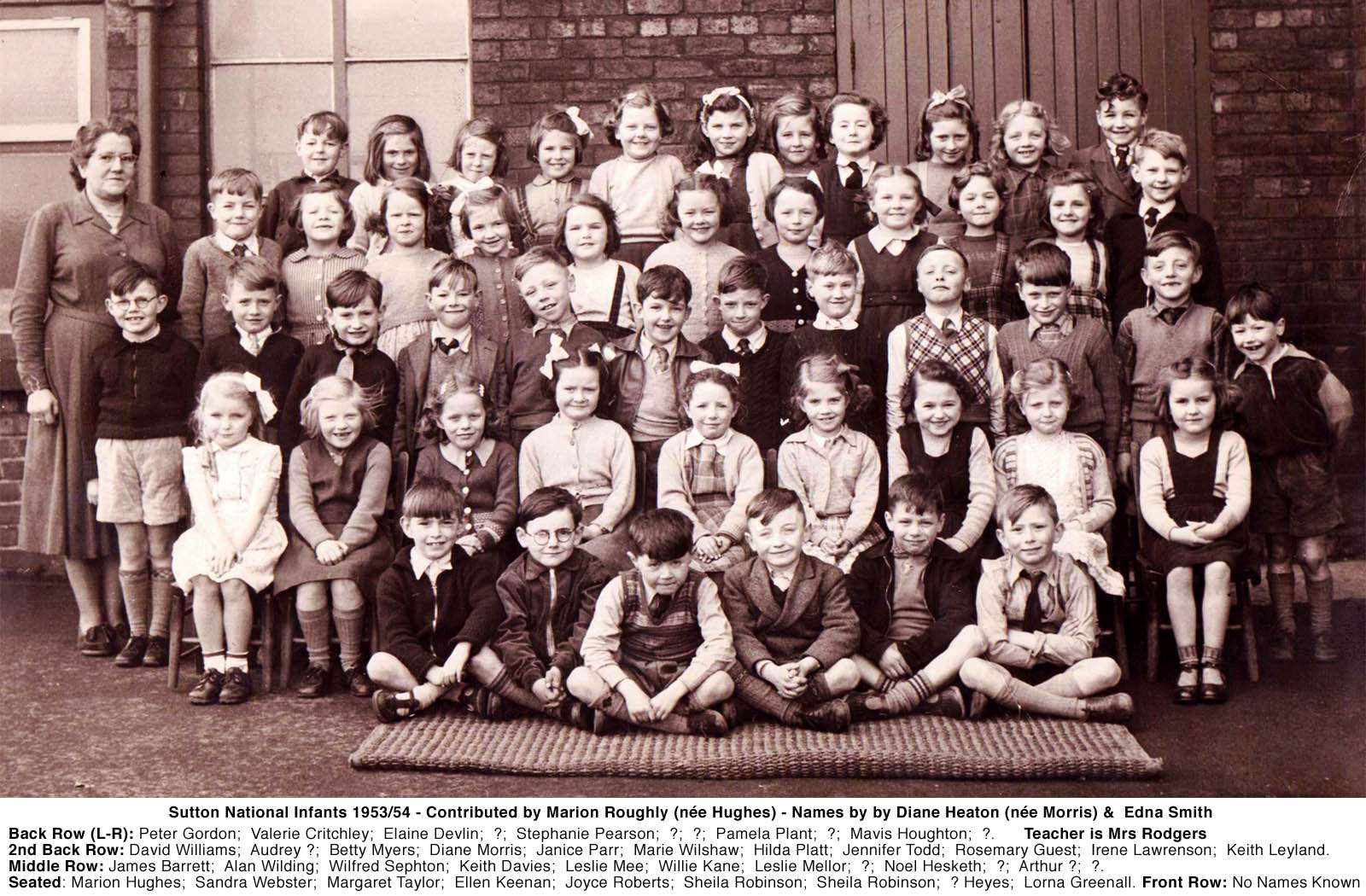An Illustrated History of Old Sutton in St Helens, Lancashire
Part 69 (of 95 parts) - Memories of Sutton Part 19
Compiled by Stephen Wainwright ©MMXX
’Head Cook & Bottlewasher: Growing Up in Post War St Helens’ by Alan Tucker
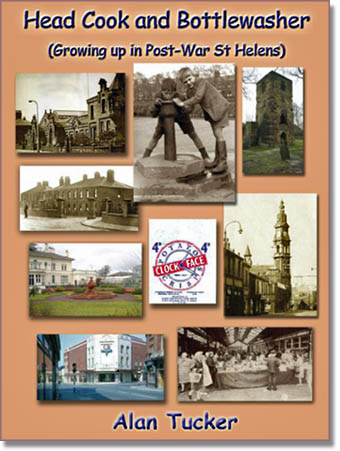
My grandparents in Lionel Street took me for frequent walks down Penlake Lane, just off Lionel Street, to see the allotments with their menagerie of pigs, hens and geese. Some times we went further afield to ramble around the local fields. Vivid memories are of the abandoned poison gas works in Reginald Road, the WW1 Battery Cob (a huge earthwork in a field that was used as a safety background barrier for the targets during rifle practice) and the incessant air traffic from the USA’s Burtonwood airbase a couple of miles away. I can also recall being taken over the railway footbridge to a cul-de-sac locally known as The Pudding Bag.
We also went into the Railway Club grounds off Penlake Lane to watch Grandpa playing bowls with the other retirees. Both my Lionel Street grandparents, the Websters, had taught at Sutton National School so they really knew how to both amuse and educate a small boy. They taught me how to read long before I went to school. There used to be a card game called Lexicon which was played with playing cards that each bore a letter of the alphabet. I can't recall how my early reading skills actually evolved but the technique involved the use of these cards.
Grandpa Webster, as well as being a great teacher was also a gifted story teller, drawing on his (strictly non-militaristic when entertaining me) experiences in the South African War for many of his tales. He also had a great store of Children’s Encyclopaedias and other educational books that he read to me until I was able to read myself. The Liverpool to Manchester railway line and the St Helens Junction station at the end of Lionel Street also featured high in my pre-school education and at the age of four I could recite the names of all the stations on it between Liverpool and Manchester. Many happy hours were spent with Grandpa Webster on the footbridge that joined the two platforms watching and waiting for the various trains. The Manchester to Liverpool express steam train was eagerly anticipated. Another train that sticks in the memory was the one that took the poor invalids to Lourdes in the hope of a miraculous cure. It had twenty packed carriages.
Whilst we had little money at home and toys were scarce, my Dad had a cousin, my Auntie Marion, who’d “married well”, as they used to say in those days, and who lived near Whiston Hospital just outside St Helens. Auntie Marion and her husband had a son named Arthur who was well-indulged in the toy department. His surplus toys were always deposited at my Lionel Street grandparents’ house, so that was another reason to look forward to my trips there.
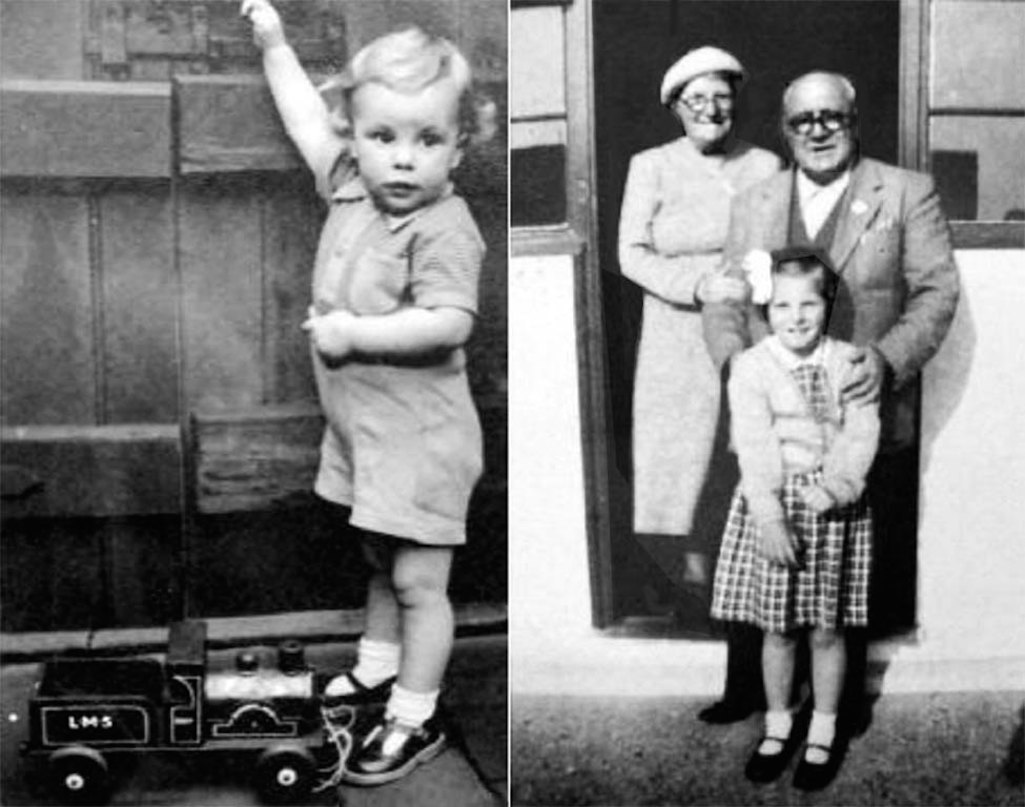
Left: Alan Tucker with his toy LMS railway engine; Right: Webster Grandparents with Barbara, sister of Alan

Alan Tucker with his toy engine and Webster Grandparents with sister Barbara

Alan with his toy engine and Webster Grandparents with sister Barbara
One Lionel Street episode that still makes me smile was when at the age of just four and with the connivance of the friendly Number 6 trolley bus conductor; I was allowed to travel on my own for the three or four miles from the Lingholme corner all the way to the St Helens Junction terminus to visit Grandma and Grandpa Webster. I'd been given a telescopic aluminium radio aerial off a WW2 tank to play with so I took this along to show Grandpa.
When I got to their house, I used the aerial to lift and let fall the heavy door-knocker high up on their front door and then hid it behind me. I can still see Grandpa looking back down the street to see who'd operated the door-knocker for me.
St Helens Junction always had a roaring coke fire in the waiting room in winter and even until the 1960s was lit by gas-mantles. In contrast to the other St Helens stations, it seemed quite clean with small beds of flowers tended by the Station Master. The short journey by rail between St Helens Junction and Shaw Street stations was like a trip back through the industrial revolution as it passed so many ancient factories and their waste-heap legacies.
Some of the smells we lived with still come to mind. Probably the worst of these was the hydrogen sulphide (rotten eggs) stench from the Sidac cellophane factory that we passed on the bus on the way to our paternal grand parents in Sutton. Just as the bus approached Sutton, on the left-hand side, was a sort of small multi-coloured lagoon with an equally multi-hued stream flowing into it. Heaven alone knows what chemicals it contained but, boy, did it stink!

’My Early Days in Sutton’ by Ken Morgan
Alan Tucker's article above brought back some good memories. He writes of his grandad, whom we at Sutton Nash called Jimmy Webster, a fine fellow to us young kids. I can still see him walking up Junction Lane to school.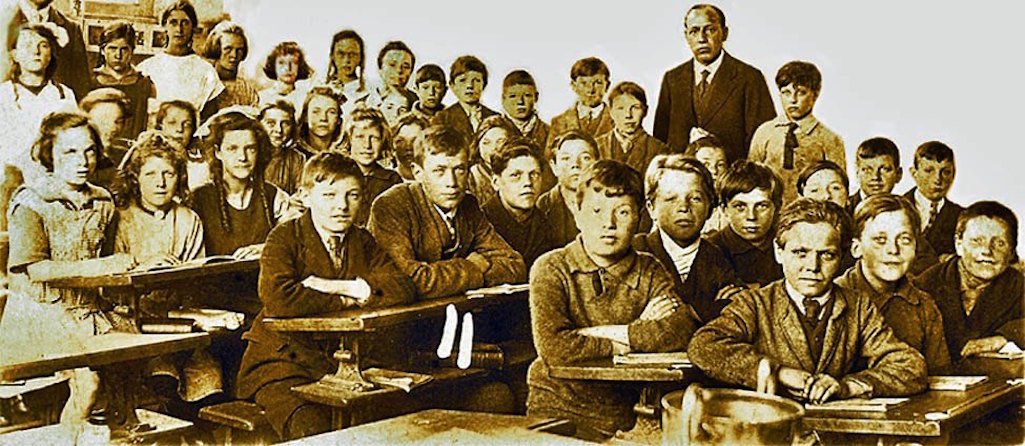
Sutton National Schoolteacher Jimmy Webster pictured on the right with a class - Contributed by Alan Tucker

Sutton National Schoolteacher Jimmy Webster pictured on the right with a class

Sutton National teacher Jimmy Webster shown on the right with a class
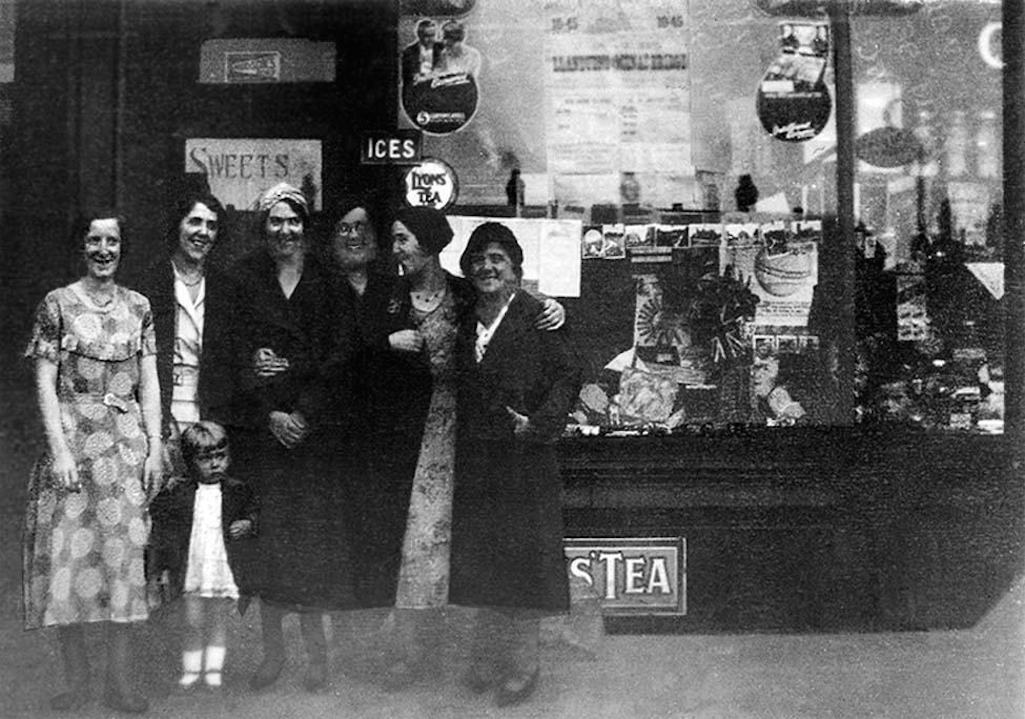
The Station Road shop c.1938 probably taken by Ken's Mum on her Box Brownie - Contributed by Ken Morgan

Station Road shop c.1938 probably taken by Ken's Mum on her Box Brownie

The Station Road shop c.1938
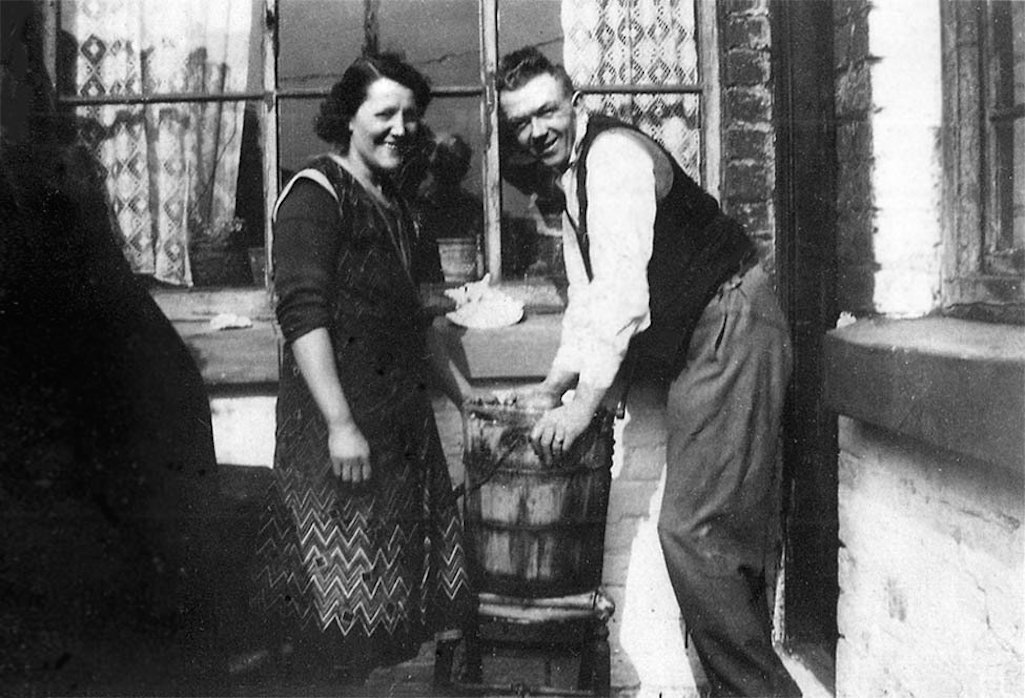
Maggie and Jim Morgan possibly with an ice cream maker at the rear of their shop in Station Road - Contributed by Ken Morgan

Maggie and Jim Morgan at the rear of their shop in Station Road, Sutton

Maggie (née Hardman) and Jim Morgan
The Bug played a large part in my life because it was opposite where I lived at 11 Wilbur Street. Many a happy hour was spent there, with my mate, Joey Foster. His dad, big Joe, used to control the rowdy queues, and acted as a bouncer. One horrible story was of an experience in 1945. I was in there when they were showing a film of Belsen Concentration Camp with bulldozers shovelling naked bodies into mass graves. Some in the audience laughed. I will never forget it. Perhaps they were embarrassed at seeing naked flesh, unusual in those days.
’My Sutton Nash Memories’ by Diane Heaton
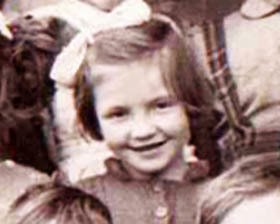
One memory I have of being at Sutton Nash was being taken onto the Tip behind the school for an afternoon out of the classroom. This was a treat on a fine day. I don't know whether it was a dumping ground or whether it was just mossland. A few "chosen" children would have the privilege of carrying a chair for each of the teachers to sit on! I also remember the headmaster Mr Anderton sometimes playing the violin for us - rather boring for us Philistines.
The photograph is the one from 1953/54 contributed by Marion Roughly (née Hughes) in which Mrs Rodgers was our teacher. My Infants’ schoolteachers were Mrs Humphreys (babies class), Miss Woodward who became Mrs Hall, and Mrs Rodgers. Miss Hawley was headmistress. In the Juniors Mr Anderton was the headmaster. In the first year I had Mrs Twist, then Mr Tickle in the 2nd year and Miss Darlington in the 3rd year. My 4th year teacher was a young woman (newly qualified I think) but I can’t remember her name. She wasn’t half as frightening as the older teachers!
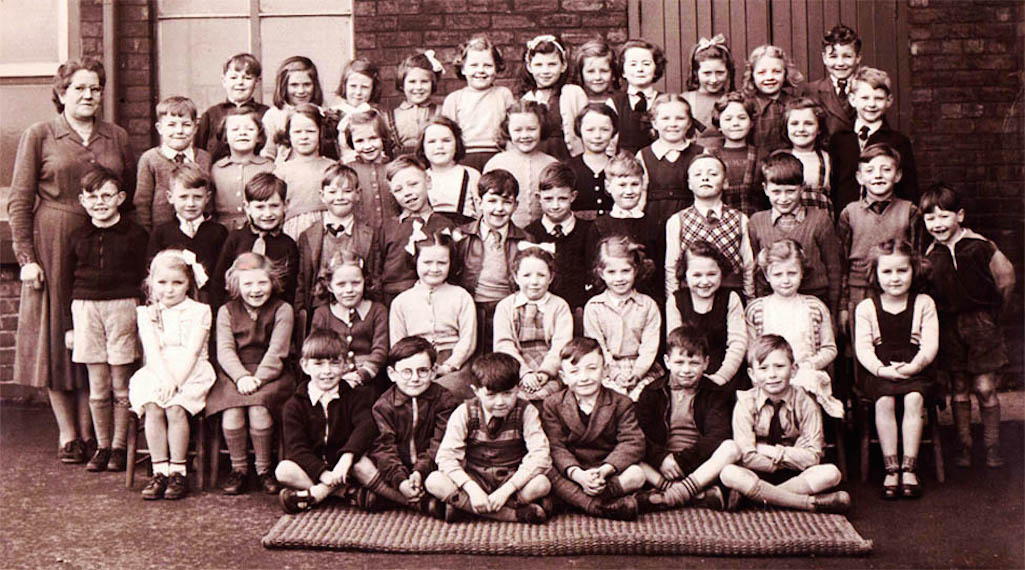
Sutton 'Nash' Infants 1953/4 - contributed by Marion Roughley (nee Hughes) - View Version With Names

Sutton 'Nash' Infants 1953/4 - contributed by Marion Roughley (nee Hughes) - View Version With Names

Sutton 'Nash' Infants 1953/4
'Memories of Davies’s Dairy' by Brenda Macdonald
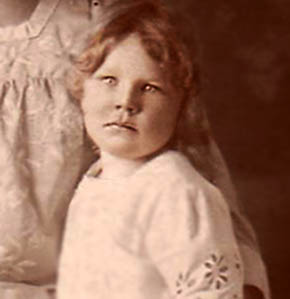
The family had a nice house and furniture, a piano and soft rugs on their floors. The oldest children were Dick and Sarah, then came Gwen and Gladys. Sarah was a good pianist but she was a shy, nervous girl and the others picked on her and made her cry. Mum said that as Gwen's friend, she was the only other child who was allowed into the dairy and house. Another reason may well have been that Mum never made fun of Sarah, like the other children did.
The Davies's also had a car, which were quite rare in Sutton in the 1920s. It was an old model with big running boards and a fabric roof with metal arms at the sides, for raising and lowering the roof. Mum was once invited to go for a drive to Southport with them. She lived with her Mum Withington (who was really her Aunt) in Ellen Street and she gave her 1/6d as spending money.
A florist and hairdressers now occupy part of the old Davies' Dairy. Mum said that the Davies's lived in the two-storey house part and had a ground floor extension built to accommodate the shop. The high wall continued round the side and the back, with big gates as high as the wall. These led to the dairy itself, where Mr Davies used to stand for hours on end, smoking his pipe and watching the milk flow down corrugated metal sheets and cooling. Mrs Davies used to get quite cross with him for doing that!
'Memories of Davies's Dairy' by Tom Williams
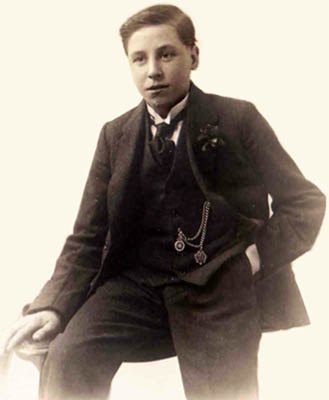

Tom’s Dad Jack Williams b. 1903
When he was alive, my dad, Jack Williams (b. 1903), told me that as a boy he had worked for Mr Davies, delivering milk with Mr Davies's horse and cart. I think the horse may have been called Jimmy. One day they came across a steam driven lorry that had gone off the road and fallen over onto its side. I think it was on a track leading to a farm where they may have sourced the milk. The horse took fright, broke its harness and galloped off, spilling all the milk churns (no bottles in those days, you bought a jug full). My dad had to walk back to the dairy where lo and behold there was the horse and a rather upset Mr Davies. My dad explained what had happened and Mr Davies took the horse all the way back to the lorry and put its nose up against it with the intention that it should not be frightened if it came across such a thing again.
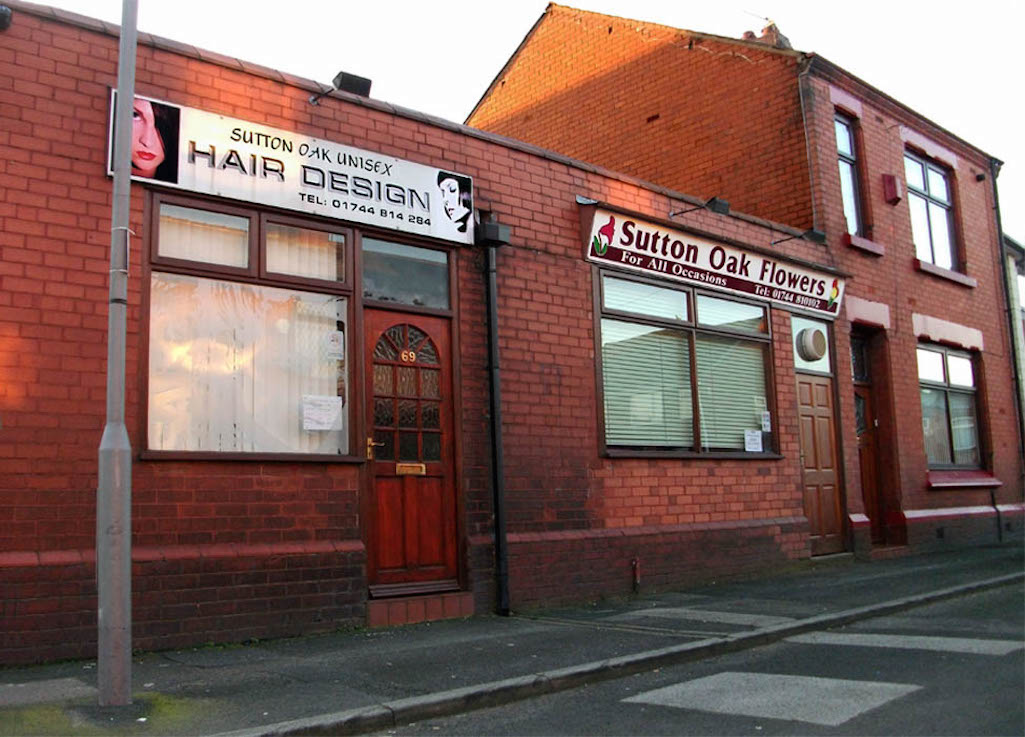
What's left of the dairy and shop owned by John Davies in Edgeworth Street, Sutton, St.Helens

What's left of the dairy owned by John Davies in Edgeworth Street

The former dairy in Edgeworth Street
'My Family at Ravenhead Glass Works' by Gill Chesney-Green
Many of my ancestors worked at Ravenhead Glass Works, which was then in Sutton Township. My 3rd Great-Grandfather, Robert Ashcroft, probably worked at the glass works all his life. From the evidence of the census returns, I can see that he was at least working there from 1841 to 1881 and his death certificate describes him as a labourer in the works. They lived at 16 Mill Row from 1861, which was also a sweet shop, I gather. Earlier they’d lived on Factory Row at the works, I presume. Robert died of senile decay in 1889 (aged 77), so he may well have had a very menial job at that time.One of his sons, John Ashcroft, my 2nd Great-Grandfather, also worked at Ravenhead Glass Works but died of pneumonia four years before his father in 1885 at the age of just 48. Many of their children also worked in the glass factory – so I assume that as soon as they could get out of school they began working there.
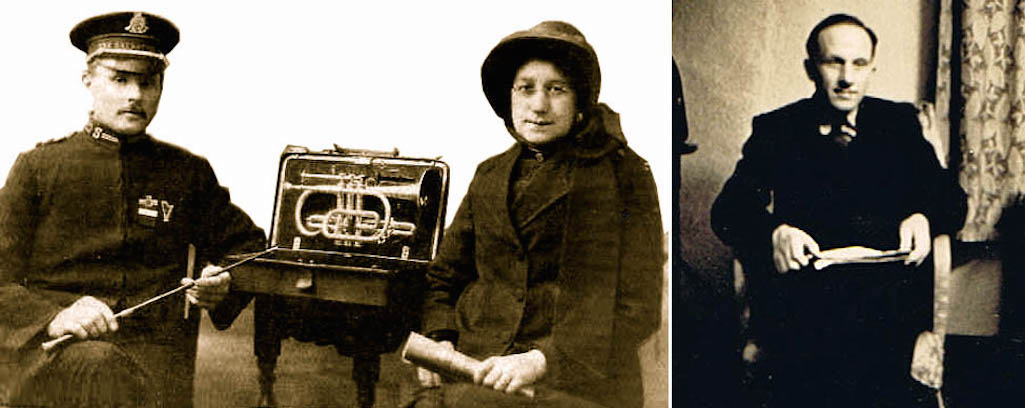
Left: Bandmaster George and Francis Tebb in 1909; Right: George Tebb (Jnr) - Contributed by Gill Chesney-Green

Left: Bandmaster George and Francis Tebb in 1909; Right: George Tebb (Jnr)

Left: George and Francis Tebb pictured in 1909; Right: George Tebb (Jnr)
George’s son, also George, my grandfather, also worked in the glass works and this was shown in the 1911 census when they lived at Boundary Road. I know for a fact that he also worked in the glass industry for many, many years and damaged his hand as a result of an accident. He was a musician, too, in the SA and played both piano and cornet prior to this accident. Afterwards he wasn’t able to play piano any more, although he still played his cornet. The accident had cut tendons in his right hand and he wasn’t able to open his hand fully as they’d had to be tied together. Thankfully, however, the accident didn’t do more damage, although he was bitterly disappointed that he could no longer play the piano.
’My Dad at Clock Face Colliery’ by Margaret Braithwaite
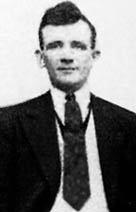
The pay, I believe, in the thirties was dreadful, about £2 10s. per week, which is why Dad had an allotment and kept chickens, which he’d got from the rag and bone man. He also did chimney sweeping for neighbours. I have an old photo taken of him (pictured right), not long after he got married when he was ill and stayed in a sanatorium near Blackpool. This must have been provided by the colliery.
The family moved to a council house down Parr when I was six and we lived in Granville Street. The house was still cramped but it had a long garden, which Dad loved. He used to walk to Peasley Cross and catch a bus to work and I used to bump into him on my way to school at St Joseph’s. I can recall getting his chewing tobacco at Robert’s shop near the Co-op and getting his ham and red Leicester cheese for his snap. Coal was always delivered in a pile outside the house and we’d lay down newspaper and carry the buckets through to the coal place. Often Dad would tell my Mam about the accidents that had taken place at work, usually with the tubs. My Dad made his own clogs on a last and he used to give me a penny and sometimes would bring home coal fossils from the pit.

Left: Clock Face Colliery; Middle: Fern fossil; Right: The sanatorium at Bispham near Blackpool

Left: Clock Face Colliery; Middle: Fern fossil; Right: Bispham sanatorium
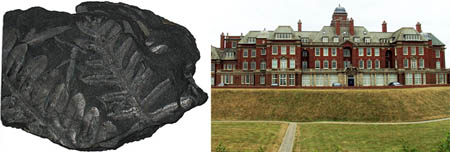
Fern fossil and sanatorium at Bispham
We then moved from Parr and lived at Clinkham Wood in a much better council house. We’d only been there for a short time when Dad had a heart attack late one night at the end of November 1957. He had returned to work after his accident and his death was sudden. I was nearly 14 and my younger brother was 10, with my older siblings being 19, 20, 21, 22 and 23. The pathologist was called Mooney and he said my Dad’s lungs were like black cement, obviously caused by the years spent underground. Work down the mine was always referred to as ‘blood money’ and it was. I recall him being prematurely aged through work and going deaf from the shot firing. I believe Clock Face was a colliery where you had to crawl to the face. What a miserable life; it was vital to have camaraderie to compensate for the inferno below ground.
I recall St Helens as being a very parochial town in the ‘50s and ‘60s. I left in 1964 to go on a teacher’s course in Cardiff. Still I did and still do love my hometown and as an art student studying illustration, went to some of the mines and drew them. Recently on TV a programme mentioned St Helens producing a chemical weapon for use in the first world war. I recall on my journeys along Dark Lane from Peasley Cross, passing what we called the ‘stinking brook’. It changed colours every day and we knew we had to keep away from it but my younger brother did fall in. However he’s still here and has returned to live in the UK after 50 years in Australia.
